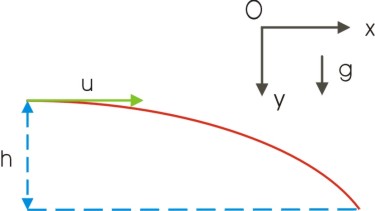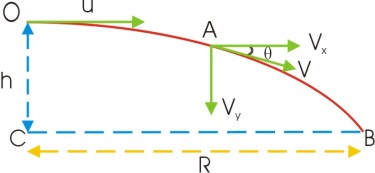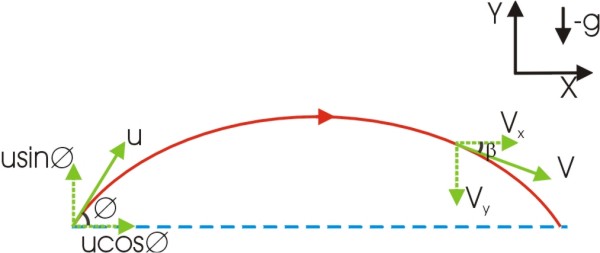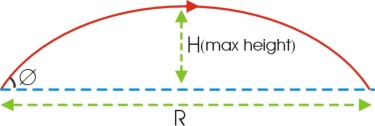Circular Motion Projectile Motion Work Energy Power
See a collection of solved examples for this topic on our website buzztutor.com
Projectile
Projectile is a body thrown with an initial velocity in the vertical plane and then it moves in two dimensions under the action of gravity alone without being propelled by any engine or fuel. Its motion is called projectile motion. The path of a projectile is called its trajectory.
Examples:
A packet released from an airplane in flight.
A golf ball in flight.
A bullet fired from a rifle.
A jet of water from a hole near the bottom of a water tank.
Projectile motion is a case of two-dimensional motion .Any case of two dimensional motion can be resolved into two cases of one dimensional motion -one along the x-axis and the other along the y-axis.The two cases can be studied separately as two cases of one dimensional motion.The results from two cases can be combined using vector algebra to see the net result
What is important to remember is that the motion along the horizontal direction does not affect the motion along the vertical direction and vice versa.Horizontal motion and vertical motion are totally independent of each other .
A body can be projected in two ways :
Horizontal projection-When the body is given an initial velocity in the horizontal direction only.
Angular projection-When the body is thrown with an initial velocity at an angle to the horizontal direction.
We will study the two cases separately.We will neglect the effect of air resistance.We will take x-axis along the horizontal direction and y-axis along the vertical direction.
Case 1Horizontal Projection
A body is thrown with an initial velocity u along the horizontal direction.We will study the motion along x and y axis separately.We will take the starting point to be at the origin.

Along x-axis |
Along y-axis |
|---|---|
| 1. Component of
initial velocity along x-axis. ux=u |
1. Component of initial
velocity along y-axis. uy=0 |
2.
Acceleration along x-axis |
2.Acceleration
along y-axis ay=g=9.8m/s2 It is directed downwards. |
| 3. Component of
velocity along the x-axis at any instant t. vx=ux + axt =u + 0 vx=u This means that the horizontal component of velocity does not change throughout the projectile motion. |
3. Component of velocity
along the y-axis at any instant t. vy=uy + ayt =0 + gt
vy=gt |
| 4. The
displacement along x-axis at any instant t x=uxt + (1/2) axt2 x=uxt
+ 0 |
4. The displacement along
y-axis at any instant t y= uyt + (1/2) ayt2 y= 0 + (1/2) ayt2 |
Equation of a trajectory(path of a projectile)
We know at any instant x = ut
t=x/u
Also, y= (1/2)gt2
Subsituting for t we get
y= (1/2)g(x/u)2
y= (1/2)(g/u2)x2
y= kx2 where k= g/(2u2 )
This is the equation of a parabola which is symmetric about the y-axis.Thus,the path of projectile,projected horizontally from a height above the ground is a parabola.
Net velocity at any instant of time t

We know ,at any instant t
vx=
u
vy= gt
v= (vx2
+ vy2)1/2
= [u2 +
(gt)2]1/2
Direction of v with the horizontal at any instant :
(angle) = tan-1 (vy/vx)= tan-1 (gt/u)
Time of
flight (T):
It is the total
time for which the projectile is in flight ( from O
to B in the diagram above)
To find T we will find
the time for vertical fall
From y= uyt
+ (1/2) gt2
When , y= h , t=T
h= 0 + (1/2) gt2
T= (2h/g)1/2
Range
(R) :
It is the horizontal distance covered
during the time of flight T.
From
x=
ut
When
t=T , x=R
R=uT
R=u(2h/g)1/2
Case 2 Angular Projection
We will now consider the case when the object is projected with an initial velocity u at an angle to the horizontal direction.
We assume that there is no air resistance .Also since the body first goes up and then comes down after reaching the highest point , we will use the Cartesian convention for signs of different physical quantities.The acceleration due to gravity 'g' will be negative as it acts downwards.
We will separate the motion into horizontal motion (motion along x-axis) and vertical motion (motion along y-axis) .We will study x-motion and y-motion separately.

| X axis | Y axis |
| 1. Component of initial velocity along
x-axis. ux=u cosΦ |
1. Component of initial velocity along
y-axis. uy=u sinΦ |
2.
Acceleration along x-axis |
2.Acceleration
along y-axis ay= -g= -9.8m/s2 (g is negative as it is acting in the downward direction) |
| 3. Component of
velocity along the x-axis at any instant t. vx=ux + axt =ucosΦ + 0= ucosΦ vx=ucosΦ This means that the horizontal component of velocity does not change throughout the projectile motion. |
3. Component of velocity
along the y-axis at any instant t. vy=uy + ayt vy=usinΦ - gt |
| 4. The
displacement along x-axis at any instant t x=uxt + (1/2) axt2 x=ucosΦ.t |
4. The displacement along
y-axis at any instant t y= uyt + (1/2) ayt2 y= usinΦ.t - (1/2)gt2 |

Equation of Trajectory (Path of projectile)
At any instant t
x= ucosΦ.t
t= x/(ucosΦ)
Also , y= usinΦ.t - (1/2)gt2
Substituting for t
y= usinΦ.x/(ucosΦ) - (1/2)g[x/(ucosΦ)]2
y= x.tanΦ - [(1/2)g.sec2.x2 ]/u2
This equation is of the form y= ax + bx2 where 'a' and 'b are constants.This is the equation of a parabola.Thus,the path of a projectile is a parabola .
Net velocity of the body at any instant of time t
vx=ucosΦ
vy=usinΦ
- gt
v= (vx2
+ vy2)1/2
Φ= tan-1(vy/vx) Where Φ is the angle that the resultant velocity(v) makes with the horizontal at any instant .

Angular Projectile motion is symmetrical about the highest point.The object will reach the highest point in time T/2 .At the highest point,the vertical component of velocity vy becomes equal to zero .
vy=usinΦ
- gt
At t=T/2 ,
vy=
0
0= usinΦ - gT/2
T= (2usinΦ)/g
Equation for vertical
distance (y component)
y= uyt
- (1/2)gt2
At t=T/2 , y=H
H= usinΦ.T/2 - (1/2)g(T/2)2
substituting
T
H= usinΦ.usinΦ/g - (1/2)g(usinΦ/g)2
= (u2sin2)/g
- (u2sin2)/2g
H= (u2sin2)/2g
Range is the total horizontal distance covered during the time of flight.
From equation for
horizontal motion, x=uxt
When t=T , x=R
R= uxT =
ucos.2usinΦ/g
= u22sinΦcosΦ/g
= u2sin2Φ/g
using 2sinΦcosΦ= sin2Φ
R= (u2sin2Φ)/g